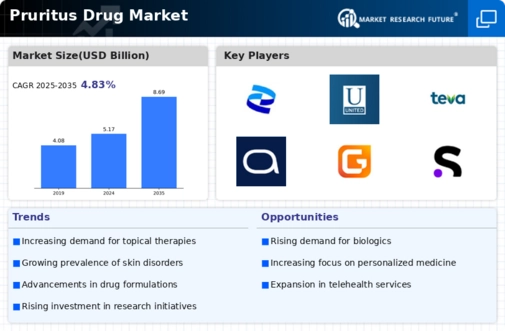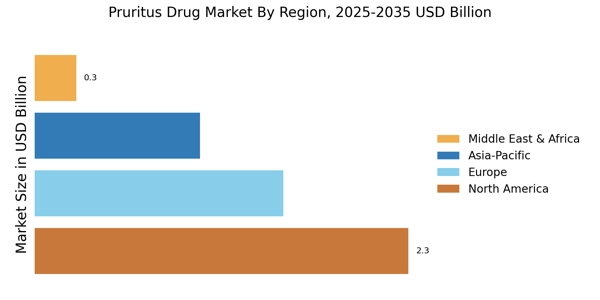Rising Geriatric Population
The aging population is a significant demographic factor driving the Pruritus Drug Market. Older adults are more susceptible to skin conditions and pruritus due to age-related changes in skin physiology and increased prevalence of chronic diseases. As the geriatric population continues to grow, the demand for effective pruritus treatments is likely to rise correspondingly. This demographic shift presents opportunities for pharmaceutical companies to develop targeted therapies that cater specifically to the needs of older patients. Consequently, the market is expected to experience growth as healthcare providers seek to address the unique challenges associated with pruritus in this population.
Advancements in Drug Development
Technological advancements in drug development are significantly influencing the Pruritus Drug Market. The emergence of novel drug delivery systems and biologics has opened new avenues for treating pruritus. For instance, the development of monoclonal antibodies and targeted therapies has shown promise in managing chronic itch associated with various dermatological conditions. Furthermore, the market is witnessing an increase in clinical trials aimed at evaluating the efficacy of new treatments. This focus on research and development is expected to enhance the therapeutic landscape, providing patients with more effective options and potentially driving market growth in the coming years.
Regulatory Support for New Treatments
Regulatory bodies are increasingly supportive of the development and approval of new treatments for pruritus, which is a crucial driver for the Pruritus Drug Market. Initiatives aimed at expediting the approval process for innovative therapies are encouraging pharmaceutical companies to invest in research and development. This regulatory environment fosters a climate of innovation, allowing for the introduction of new drugs that can effectively manage pruritus. As a result, the market is likely to benefit from a steady influx of novel treatment options, enhancing patient access to effective therapies and potentially driving overall market growth.
Growing Awareness of Treatment Options
There is a marked increase in awareness regarding treatment options for pruritus, which is positively impacting the Pruritus Drug Market. Patients are becoming more informed about available therapies, leading to higher treatment-seeking behavior. This trend is supported by educational campaigns and initiatives from healthcare providers aimed at improving patient knowledge about pruritus and its management. As a result, more individuals are likely to consult healthcare professionals for effective treatment solutions, thereby increasing the demand for pruritus medications. This heightened awareness is expected to contribute to market expansion as patients actively seek relief from their symptoms.
Increasing Prevalence of Skin Disorders
The rising incidence of skin disorders, such as eczema and psoriasis, is a notable driver for the Pruritus Drug Market. According to recent estimates, skin conditions affect millions of individuals worldwide, leading to a heightened demand for effective pruritus treatments. This trend is further exacerbated by environmental factors and lifestyle changes that contribute to skin irritations. As a result, pharmaceutical companies are increasingly focusing on developing innovative therapies to address these conditions. The growing awareness of skin health and the importance of effective treatment options is likely to propel the market forward, as patients seek relief from chronic itching and discomfort associated with these disorders.


















Leave a Comment